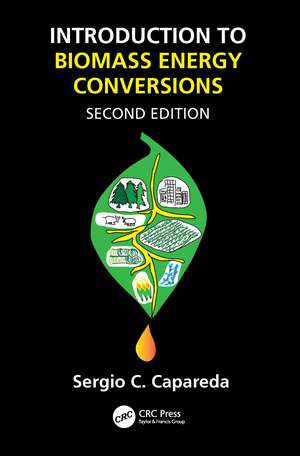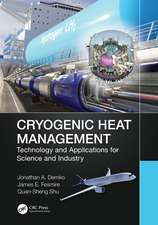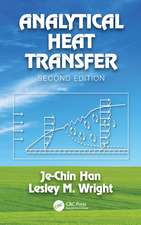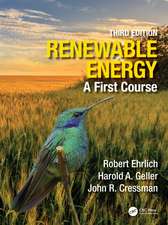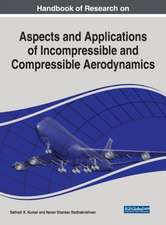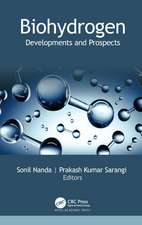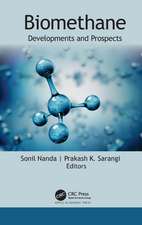Introduction to Biomass Energy Conversions
Autor Sergio Caparedaen Limba Engleză Hardback – 7 noi 2023
With extended discussions of new sustainability issues in biofuels production, such as carbon capture and sequestration, the second edition has been updated with carbon footprint work life cycle analysis, the growing circular economy, and newer research directions of biomass resources, such as graphene production from biochar. This book covers thermo-chemical conversion processes, including torrefaction, pyrolysis, gasification and advanced gasification, biomass liquefaction, and combustion.
This book is intended for senior undergraduate students taking Renewable Energy Conversions, Bio Energy, Biomass Energy, Introduction to Biofuels, and Sustainability Engineering courses.
This book also features end-of-chapter problems, exercises, and case studies with a Solutions Manual available for instructors.
The eBook+ version includes the following digital enhancements:
- Audio player. Students can listen to an audio overview at the start of each chapter.
- Pop-ups. Students can hover over important technical terms and keywords to instantly view definitions and actual images such as of biomass materials, products, equipment and pilot facilities.
- Problem-solving and objective type questions. Over 450 questions are included. Multiple choice quiz items, with answers and solutions, are provided at the end of each chapter. These quizzes are carefully designed to satisfy all the key learning objectives for each chapter. Indices for commonly used units and conversions, and glossary of terms used in biomass conversion systems, are provided to aid the students in problem solving.
- Case studies. Students will tackle case studies on bioenergy techno-economics and feasibility, particularly for biodiesel, bioethanol, and biogas productions, as well as pyrolysis and gasification systems. MS Excel templates are provided to conduct economic sensitivity analysis for each project. Included in the case study package are short videos to guide the students on how to navigate through each case study project.
Preț: 887.74 lei
Preț vechi: 975.54 lei
-9% Nou
Puncte Express: 1332
Preț estimativ în valută:
169.86€ • 177.83$ • 140.56£
169.86€ • 177.83$ • 140.56£
Carte disponibilă
Livrare economică 18 martie-01 aprilie
Livrare express 01-07 martie pentru 108.50 lei
Preluare comenzi: 021 569.72.76
Specificații
ISBN-13: 9781032278339
ISBN-10: 1032278331
Pagini: 572
Ilustrații: 90 Tables, black and white; 97 Line drawings, black and white; 7 Halftones, black and white; 104 Illustrations, black and white
Dimensiuni: 156 x 234 x 39 mm
Greutate: 0.98 kg
Ediția:2 ed
Editura: CRC Press
Colecția CRC Press
Locul publicării:Boca Raton, United States
ISBN-10: 1032278331
Pagini: 572
Ilustrații: 90 Tables, black and white; 97 Line drawings, black and white; 7 Halftones, black and white; 104 Illustrations, black and white
Dimensiuni: 156 x 234 x 39 mm
Greutate: 0.98 kg
Ediția:2 ed
Editura: CRC Press
Colecția CRC Press
Locul publicării:Boca Raton, United States
Public țintă
Undergraduate AdvancedCuprins
1. Biomass as an Energy Source. 2. Biomass Conversion Processes. 3. Biomass Properties for Thermal Conversion. 4. Biomass Properties for Biological Conversion. 5. Biodiesel Production. 6. Bioethanol Production. 7. Biogas Production. 8. Torrefaction. 9. Pyrolysis. 10. Gasification. 11. Advanced Gasification. 12. Biomass Liquefaction. 13. Biomass Combustion. 14. Biomass Sustainability Issues. Appendix A. Appendix B.
Notă biografică
Sergio C. Capareda is a Professor at Texas A&M University, a licensed Professional Engineer in Texas, a Faculty Fellow, and an active member of the American Society of Agricultural and Biological Engineers. He earned a bachelor of science degree in agricultural engineering from the University of the Philippines at Los Baños (UPLB), a master of engineering degree in energy technology from the Asian Institute of Technology in Bangkok, Thailand, and a PhD degree in agricultural engineering from Texas A&M University (TAMU) in the United States.
After obtaining his PhD in 1990, Capareda returned to the Philippines to embark on an academic career in the field of biomass conversions and renewable energy at UPLB. From 2000-2003, he served as director of the Institute of Agricultural Engineering at UPLB and program manager of the Agricultural Mechanization Development Program (now BIOMECH, Center of Agri-fisheries and Biosystems Mechanization), a former United Nations Development Program (UNDP). Dr. Capareda was appointed faculty at TAMU in 2005, where he developed and established the BioEnergy Testing and Analysis Laboratory.
Dr. Capareda has authored or co-authored more than 113 refereed journal publications, four book chapters and two textbooks on biomass conversions and renewable energy. With some colleagues at Texas A&M University, he holds two patents - Integrated Biofuel Production System and Pyrolysis and Gasification System for Biomass Feedstock.
After obtaining his PhD in 1990, Capareda returned to the Philippines to embark on an academic career in the field of biomass conversions and renewable energy at UPLB. From 2000-2003, he served as director of the Institute of Agricultural Engineering at UPLB and program manager of the Agricultural Mechanization Development Program (now BIOMECH, Center of Agri-fisheries and Biosystems Mechanization), a former United Nations Development Program (UNDP). Dr. Capareda was appointed faculty at TAMU in 2005, where he developed and established the BioEnergy Testing and Analysis Laboratory.
Dr. Capareda has authored or co-authored more than 113 refereed journal publications, four book chapters and two textbooks on biomass conversions and renewable energy. With some colleagues at Texas A&M University, he holds two patents - Integrated Biofuel Production System and Pyrolysis and Gasification System for Biomass Feedstock.
Descriere
Introduction to Biomass Energy Conversions explores biomass energy conversions and characterization using practical examples and real-world scenarios. It begins with biomass resource estimation and extends to commercialization pathways for economical biomass conversion into high value materials, chemicals, and fuels.
